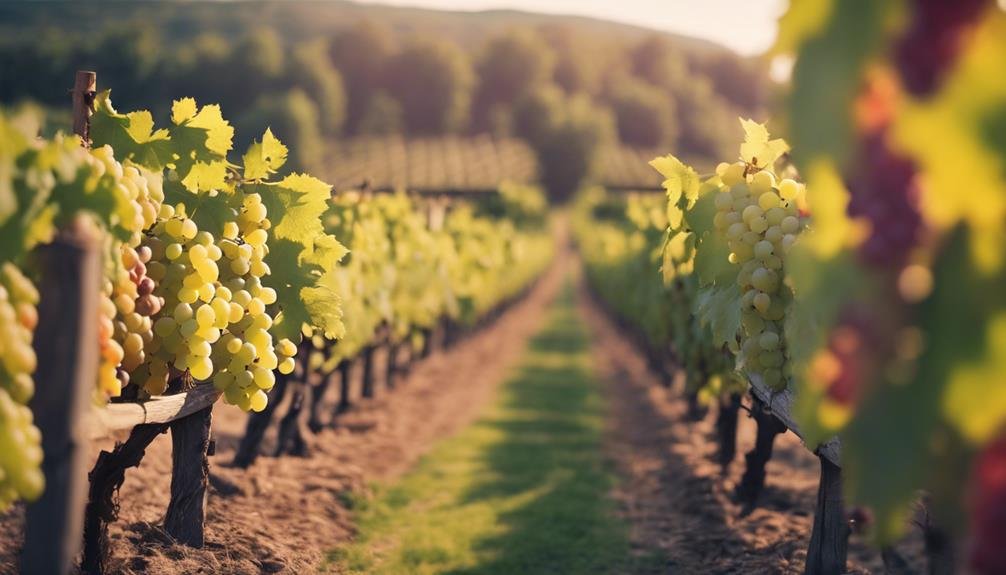Exploring the ancient origins of wine reveals a fascinating journey dating back to West Asia. Despite mysterious beginnings, discoveries in Armenia and Georgia provide insight into early winemaking. The Shulaveri-Shomu people are identified as early winemakers through genetic research. Southeastern Anatolia's wild grape vines bear resemblance to cultivated ones, hinting at a probable birthplace for winemaking. Spread across civilizations by Phoenicians and Greeks, wine transcended borders, influenced by cultural exchanges and trade routes. The diversity of wine grape varieties offers a rich tapestry of flavors shaped by climate and genetic preservation efforts. Discover more about wine's enigmatic past and evolution.
Origins of Wine Grape Cultivation
The inception of wine grape cultivation traces back to ancient times in West Asia, where the origins of winemaking remain shrouded in mystery despite evidence pointing to its early beginnings.
Archaeological discoveries in Armenia and grape residue found in Georgia provide important insights into the early practices of winemaking. Genetic research suggests that the Shulaveri-Shomu people might have been among the first to engage in winemaking activities.
Wild grape vines discovered in Southeastern Anatolia closely resemble cultivated vines, hinting at a potential birthplace for winemaking. These findings highlight the rich history of wine production in the region and offer valuable clues about the origins of this ancient practice.
Spread of Wine Across Civilizations
Journeying through various civilizations, wine traversed borders and cultures, carrying with it the essence of its origins and evolving into a symbol of shared heritage. Cultural exchanges and trade routes played pivotal roles in the spread of wine grapes, allowing the Phoenicians and Greeks to introduce winemaking to the Mediterranean region. This exchange not only facilitated the physical movement of vines but also spurred the exchange of knowledge and techniques, enriching winemaking practices. The table below provides a glimpse into the diverse civilizations that contributed to the expansion of wine across regions:
| Civilizations | Contribution |
|---|---|
| Phoenicians | Introduced winemaking to the Mediterranean |
| Greeks | Spread wine culture through trade routes |
| Romans | Established vineyard practices in conquered regions |
Diversity in Wine Grape Varieties

Exploring the vast array of wine grape varieties reveals a rich tapestry of flavors and characteristics that reflect the diverse climates and regions where they thrive. Climate adaptation is important as different grape varieties have evolved to thrive in specific environmental conditions, contributing to the unique taste profiles of wines.
Genetic preservation is necessary to maintain the diversity of grape varieties, ensuring resilience against diseases and reducing the need for pesticides. While popular grapes like Cabernet Sauvignon dominate vineyards, preserving rare and indigenous varieties is essential for maintaining biodiversity in viticulture.
Italy and France boast high grape variety diversity, a result of their long history of winemaking and genetic preservation efforts. Embracing various grape varieties not only enriches the wine tasting experience but also supports the conservation of unique flavors in winemaking.
Challenges to Grape Diversity
Amidst the proliferation of popular grape varieties in vineyards worldwide, the preservation of grape diversity faces significant challenges.
- Intensive farming practices prioritize high-yielding varieties over preserving heritage grapes.
- Climate change impacts traditional grape-growing regions, threatening unique varieties.
- Globalization leads to the dominance of a few commercially successful grapes, endangering lesser-known varieties.
- Sustainable practices such as organic and biodynamic farming can aid in preserving rare grape varieties.
- Encouraging experimentation with different grape varieties and supporting small vineyards can help maintain diversity.
Promoting Diversity in Winemaking

Promoting diversity in winemaking is essential for preserving the rich heritage of grape varieties and fostering innovation in the industry. Exploring rare varieties and supporting indigenous grapes are important steps in maintaining a diverse and sustainable winemaking landscape.
By encouraging the cultivation of lesser-known grape varieties, winemakers can reveal unique flavors and aromas, adding depth to the world of wine. Embracing indigenous grapes not only honors the cultural significance of certain regions but also contributes to biodiversity and resilience in vineyards.
To promote diversity in winemaking, it is important for consumers to seek out and appreciate wines made from a wide range of grape varieties, ensuring the continued existence and growth of rare and indigenous grapes in the ever-evolving wine industry.
Frequently Asked Questions
How Did Early Winemakers Preserve and Store Their Wine?
Early winemakers preserved and stored their wine using fermentation vessels like clay amphorae buried in underground cellars. This method guaranteed a consistent temperature for fermentation and aging, safeguarding the wine from light and temperature fluctuations.
What Role Did Climate Play in the Spread of Wine Grapes?
Climate, with its dance of soil composition, sunlight, temperature fluctuations, and precipitation, choreographed the spread of wine grapes, guiding their journey from West Asia to the Mediterranean through civilizations, shaping grape mutations and vineyard landscapes.
Are There Any Ancient Winemaking Tools That Have Been Discovered?
Archaeological finds have revealed ancient winemaking tools, shedding light on early vinification techniques. Discoveries like clay vessels and grape presses provide insights into the craftsmanship of early winemakers, offering a glimpse into the origins of this revered beverage.
How Do Popular Grape Varieties Impact Lesser-Known Ones?
Popular grape varieties dominate the wine market, overshadowing lesser-known ones. This impacts grape diversity, leading to the decline of rare varieties. Encouraging exploration of new grape varieties is essential to preserve diversity in winemaking and vineyards.
What Measures Can Be Taken to Protect Endangered Grape Varieties?
To protect endangered grape varieties, genetic preservation programs should be established. Sustainable cultivation practices can promote their growth. Increasing consumer awareness of rare grapes and their unique flavors can create market demand, ensuring their survival in the wine industry.
Conclusion
In the intricate tapestry of wine's history, the enigmatic origins of grape cultivation have sparked a journey of discovery across civilizations.
As we navigate the complexities of grape diversity and the challenges faced in preserving it, the imperative of promoting new varietals becomes clear.
Embracing the legacy of ancient winemakers and the diversity of grape varieties, we are reminded of the enduring allure and richness of wine's mysterious beginnings.